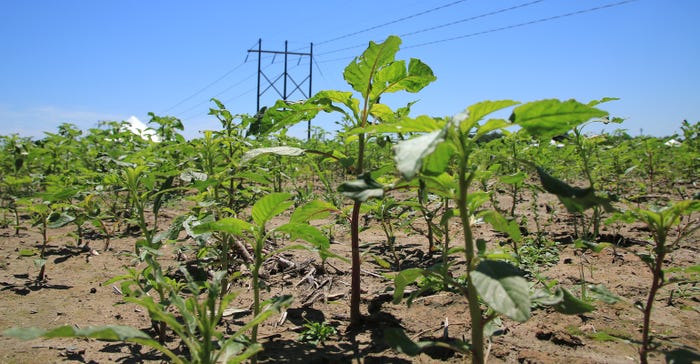
University of Illinois weed scientist Aaron Hager says there’s no evidence to support a claim he’s often heard: that Illinois soybean farmers have no other option to combat resistant weeds than the dicamba herbicide platform.
Historically, Hager says relying on any one chemical solution makes for resistant weeds. He says farmers should use both chemical and non-chemical methods to eliminate weed seed production.
He’s not kidding about the non-chemical route. “There’s always weed hooks,” Hager says, carefully adding, “but it doesn’t have to be every year.”
He’s seen a cavalier attitude among Illinois farmers who deal with glyphosate-resistant waterhemp by “opening another jug” with the dicamba trait platform.
Our neighbors to the south shared a similar attitude about Palmer amaranth several years ago, he adds. Georgia and Arkansas farmers thought they could use chemicals exclusively, but surviving weeds carried resistant traits and produced thousands of seeds per plant.
Eventually, those farmers doubled their weed control expenses, because they had to bring in chopping crews and use more herbicide.
“You put a chopping crew in that field the first year, and it’s pure misery,” Hager says. “The second year is still pretty tough. By the third year, it’s getting a lot easier. And maybe by year four and five, you’re just kind of going through the field, and every now and then, hooking a plant and killing it.”
He notes that the earlier farmers adopt a similar no-weed-seed policy, the sooner they avert large buildups.

EARLY RISER: Early emergent waterhemp can tower over soybean fields, especially when the soybeans are planted late and residual control isn’t renewed.

Outside of dicamba, growers look to Liberty or the Enlist trait systems to fight weeds that grew resistant to the glyphosate systems adopted across the Corn Belt starting in the ’90s. With these and non-GMO strategies as well, robust preemergence applications are necessary to help ensure fewer weed seeds are added to the seed bank every year.
Hager says tillage, mowing, row cultivating and other mechanical means of weed control will also be necessary depending on the grower’s conditions.
No. 1 concern
Was Illinois a “perfect storm” for dicamba complaints in 2019? Karen Corrigan, McGillicuddy Corrigan Agronomics, thinks so, thanks to historic delays in planting that caused farmers using the dicamba system to spray around the same time. The result: 708 dicamba-related complaints to the Illinois Department of Agriculture, up from 330 in 2018 and 246 in 2017.
“All you needed was one wrong night, and it all went ‘poof’ right around the same time,” Corrigan says.
While IDOA set a July 15 cutoff for dicamba application last year, high temperatures present up until that date resulted in dicamba volatilizing and injuring more mature soybeans. That’s why in crafting his transition to non-GMO soybeans, Bureau County, Ill., farmer Matt Foes says his No. 1 concern is dicamba volatilization and drift from neighbors. His No. 2 concern is weeds. He’s talking with neighbors now and marking up fields to prepare for the season.
“If damage happens early in the growing season, its impact on yield will be negligible or non-existent. Which is why the cutoffs are in place, so that if there is volatility, it hits early in the season instead of when beans are in reproductive phase,” Foes says, adding the 2020 cutoff is June 20, and farmers can’t spray if the forecast shows temperatures above 85 degrees F.
About the Author(s)
You May Also Like




